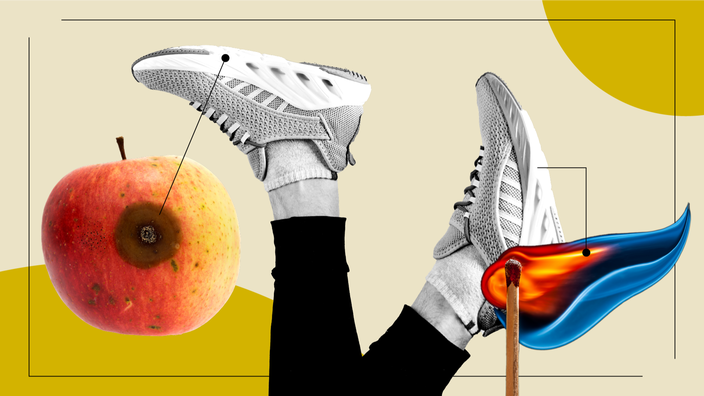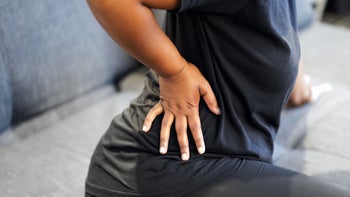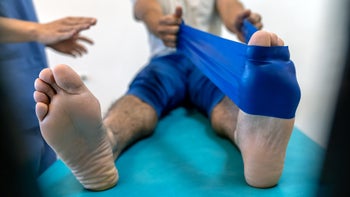
What Does Plantar Fasciitis Feel Like?
Key takeaways:
Plantar fasciitis is one of the most common types of foot pain.
It can feel like a bruise or sharp pain on the bottom of your foot.
For some people, stretching helps ease the pain. For others, wearing supportive shoes helps.

Plantar fasciitis, characterized by tightness and throbbing pain at the bottom of the foot, can be mild or severe, easily resolved, or stubbornly resistant to treatment.
Caused by inflammation of the thick tissue band that connects the heel to the toes, it tends to strike people who spend a lot of time on their feet. Some people find relief by stretching, changing shoes, or taking time off from activities like distance running. Others turn to surgery to detach the tissue from the heel bone. Its persistence can be frustrating.
Here is how three people describe their experiences with plantar fasciitis.
Search and compare options
Like a throbbing bruise on the edge of her heel
Dr. Sharon Swencki, a 49-year-old emergency physician in Columbia, Maryland, has had plantar fasciitis twice, both times when she was running more miles than usual to prepare for fall races.
In 2017, it began with a sensation of tightness on the bottom of her left foot, particularly first thing in the morning or in the first steps of a run. She treated it by rolling the arch of her foot over an exercise ball, and doing stretches and exercises recommended by a physical therapist. She also wore a boot for 2 weeks to take pressure off the tissue.
She also changed the shoes she wears in the hospital, switching from clogs with wooden soles to Birkenstocks, the German brand of sandals known for softer soles and molded cork footbeds.
After 2 pain-free years, plantar fasciitis struck again, this time on her right foot.
“It was more severe,” she says. “It just hurt all the time. It felt like a throbbing bruise on the edge of my heel. The mornings were hard. If I touched it, it felt like I was pushing on a bruise, though it wasn’t hot to the touch.”

She deferred her 2019 entry in the Chicago Marathon and went back to stretching and rolling her foot over a ball.
“I was about to give up when it just resolved,” she says.
Sharon ran the Chicago Marathon in 2021.
‘It’s never-ending’
Thomas King says he has tried everything to control his plantar fasciitis, including physical therapy, anti-inflammatory medications, acupuncture, dry needling, and finally surgery to release the tissue band.
Each brought some relief but didn’t end his plantar fasciitis woes.
“It’s never-ending,” he says with a sigh.
Thomas, a 31-year-old hotel guest service representative who lives on Long Island, says he first experienced plantar fasciitis when he was 15 or 16. Custom orthotics and acupuncture kept the pain under control until a car accident at age 29 seemed to bring it back, only worse.
“At times, it feels like there are razor blades at the bottom of my feet, right at the arch,” says Thomas, who was riding in a car that was rear-ended. It comes and goes, feeling the worst first thing in the morning and after too much walking or standing, he says.

Surgery to release the band on his left foot helped, but “was not the miracle I thought it would be,” he says. Thomas finds some relief wearing Oofos, molded shoes that are said to provide stability while absorbing impact. And he’s gotten an accommodation at work: He can now sit while on the job.
Burning across the soles of her feet
As a production designer in Los Angeles, 61-year-old Robyn Coburn can be on her feet for 8 to 10 hours at a time, as she arranges props and scenery for film and theater productions.
About 5 years ago, she started to feel soreness and burning across the soles of her feet. A quick internet search told her it was plantar fasciitis.
“It got worse with activity, which was unfortunate because I like to walk a lot,” Robyn says. “I used to walk in my neighborhood every morning. That was my exercise, but my feet got more and more sore.”

She stopped her daily walks and began searching for shoes that would relieve her discomfort, eventually discovering that Birkenstock sandals were best. She puts them on first thing in the morning, because hardwood floors seem to worsen the pain.
She can’t wear open-toed shoes on movie sets, so she relies on a Skechers sneakers called GO Walk Massage Fit, with wavy soles that seem to cushion the impact of walking and standing.
She has also switched from walking to riding a stationary bike, and she has lost 45 pounds. All these management techniques seem to help. She used to take ibuprofen when the pain was particularly bad, but lately she hasn’t needed it.
After a recent long day on a movie set, Robyn says she felt only a little soreness. “It was like a miracle,” she says.
What does the doctor say?

Patricia Pinto-Garcia, MD, MPH
Medical Editor
The plantar fascia is a thick band of tissue that connects your heel to your toes. It supports the bones and muscles on the bottom of your foot and helps create your foot arch.
Plantar fasciitis develops when the plantar fascia gets inflamed and irritated. The plantar fascia tends to get irritated where it meets the heel, which is why most people experience heel pain with plantar fasciitis. But you can have pain anywhere along the bottom of your foot, especially along the arch.
Usually, plantar fasciitis goes away on its own. The body repairs the inflammation and your symptoms go away. But plantar fasciitis can come back, and it can get harder for your body to repair the damage over time. You can also develop complications like heel spurs, which makes it harder for inflammation to go away.
The good news is that the same things that relieve plantar fasciitis may also help it from coming back. So be kind to your feet and make sure to:
Do regular foot stretches, especially before and after exercise
Wear footwear with good heel and arch support
Change out running (and frequently worn) shoes regularly
Intermittently change up activities to lessen pressure on your feet
Don’t forget to reach out to your healthcare provider when you have a plantar fasciitis flare. There are over-the-counter and prescription anti-inflammatory medications that can help relieve your symptoms. If you have frequent bouts of plantar fasciitis, your healthcare provider may also be able to offer you other options, like steroid injections.
Why trust our experts?




























